This page is based on this
Wikipedia article Text is available under the
CC BY-SA 4.0 license; additional terms may apply.
Images, videos and audio are available under their respective licenses.

The Arctiinae are a large and diverse subfamily of moths, with around 11,000 species found all over the world, including 6,000 neotropical species. This group includes the groups commonly known as tiger moths, which usually have bright colours, footmen, which are usually much drabber, lichen moths, and wasp moths. Many species have "hairy" caterpillars that are popularly known as woolly bears or woolly worms. The scientific name of this subfamily refers to this hairiness. Some species within the Arctiinae have the word “tussock” in their common name due to people misidentifying them as members of the Lymantriinae based on the characteristics of the larvae.
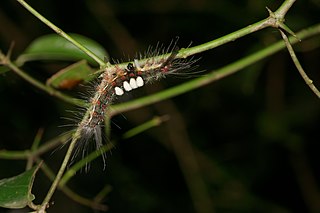
The Lymantriinae are a subfamily of moths of the family Erebidae.
The Catocalini are a tribe of moths in the family Erebidae. Adults of many species in the tribe are called underwing moths due to their vividly colored hindwings that are often covered by contrastingly dark, drab forewings.

The Calpinae are a subfamily of moths in the family Erebidae. This subfamily includes many species of moths that have a pointed and barbed proboscis adapted to piercing the skins of fruit to feed on juice, and in the case of the several Calyptra species of vampire moths, to piercing the skins of mammals to feed on blood. The subfamily contains some large moths with wingspans longer than 5 cm (2 in).
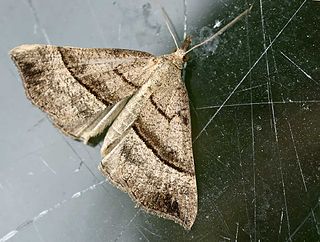
The Hypeninae are a subfamily of moths in the family Erebidae. A notable species is Mecistoptera griseifusa, which lives solely on tears it drinks with its proboscis.
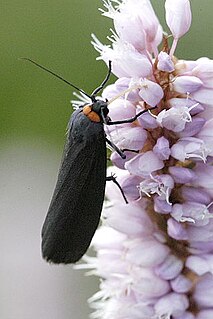
The Lithosiini are a tribe of lichen moths in the family Erebidae.
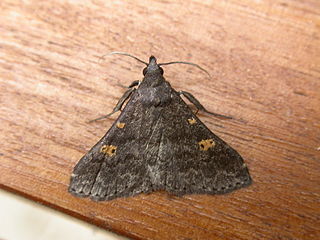
Naarda is a genus of moths containing 96 species. It was described by Francis Walker in 1866 and is in the family Erebidae.

Baniana is a genus of moths of the family Erebidae. The genus was previously classified in the subfamily Calpinae of the family Noctuidae.

Baniana minor is a species of moth of the family Erebidae. It occurs in open woodland/grassland scrub habitats in southeastern Arizona and also occurs, probably in similar habitats in the Guanacaste Province in Costa Rica.

Baniana gobar is a species of moth of the family Erebidae. It is found in Mexico.

Anoba trigonoides is a species of moth of the family Erebidae. It is found in South America and Central America, including Costa Rica, Paraguay and Brazil.

The Erebinae are a subfamily of moths in the family Erebidae. Erebine moths are found on all continents except Antarctica, but reach their greatest diversity in the tropics. While the exact number of species belonging to the Erebinae is not known, the subfamily is estimated to include around 10,000 species. Some well-known Erebinae include Underwing moths (Catocala), and Witch moths (Thermesiini). Many of the species in the subfamily have medium to large wingspans, up to nearly 30 cm in the White Witch moth, which has the widest wingspan of all Lepidoptera. Erebine caterpillars feed on a broad range of plants; many species feed on grasses and legumes, and a few are pests of castor bean, sugarcane, rice, as well as pistachios and blackberries.
The Micronoctuini are a tribe of moths in the family Erebidae that includes about 400 described species. Typical species in the tribe have bifine hindwing venation and are smaller than those in other noctuoid moths. Micronoctua karsholti is the smallest of all species in the superfamily Noctuoidea.

Baniana relapsa is a species of moth of the family Erebidae. It is found on the Antilles.
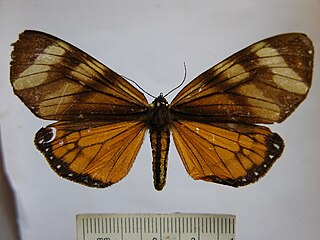
Dysschema eurocilia is a moth of the family Erebidae. It is a common species throughout
tropical America, where it has been recorded from the Antilles, Central America and South America.
The Anobinae are a subfamily of moths in the family Erebidae. Common morphological characteristics of Anobine moths include a dark head and prothoracic collar, lighter color on the thorax, and either bipectinate antennae or antennae with flagellomeral setae in males.
The Boletobiinae are a subfamily of moths in the family Erebidae, containing about 956 species.
The Cisthenina are a subtribe of lichen moths in the family Erebidae, currently containing 428 described species.
Deinopa angitia is a species of owlet moths in the family Erebidae. It is found in Central America and North America.














